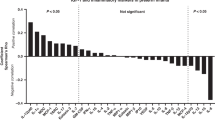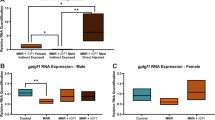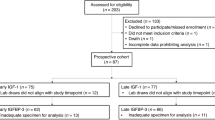Abstract
ABSTRACT: Plasma, amniotic fluid, and tissue concentrations of IGF-I were examined in nutritionally deprived, growth-retarded fetal rats to determine whether IGF-I concentration serves as a marker for nutritional status. Growth retardation was induced by 72 h of maternal fasting. Twenty-three control and 17 growth-retarded fetuses were individually analyzed and compared. Plasma IGF-I concentrations were significantly lower in test compared with control animals (test 56.8 ± 14.9, control 87.4 ± 17.5 ng/mL, p < 0.01). Amniotic fluid IGF-I concentrations were not different (test 14.0 ± 8.7, control 12.2 ± 2.6 ng/mL). IGF-I concentrations obtained from both placental and hepatic tissues were lower in test compared with control animals [placenta: test 293 ± 25 versus control 655 ± 114 ng/g (p < 0.001); hepatic: test 173 ± 38 versus control 230 ± 51 ng/g (p < 0.01)]. Reductions in fetal, placental, and hepatic weights in test animals were more closely related to changes in placental IGF-I concentration than to either plasma or hepatic IGF-I concentrations. We conclude that fetal plasma IGF-I is a valuable marker for intrauterine substrate deprivation and that the growth-retarded rat fetus is accurately identified and specifically characterized by a low placental concentration of extractable IGF-I.
Similar content being viewed by others
Log in or create a free account to read this content
Gain free access to this article, as well as selected content from this journal and more on nature.com
or
Author information
Authors and Affiliations
Rights and permissions
About this article
Cite this article
Bernstein, I., DeSouza, M. & Copeland, K. Insulin-Like Growth Factor I in Substrate-Deprived, Growth-Retarded Fetal Rats. Pediatr Res 30, 154–157 (1991). https://doi.org/10.1203/00006450-199108000-00006
Received:
Accepted:
Issue date:
DOI: https://doi.org/10.1203/00006450-199108000-00006



